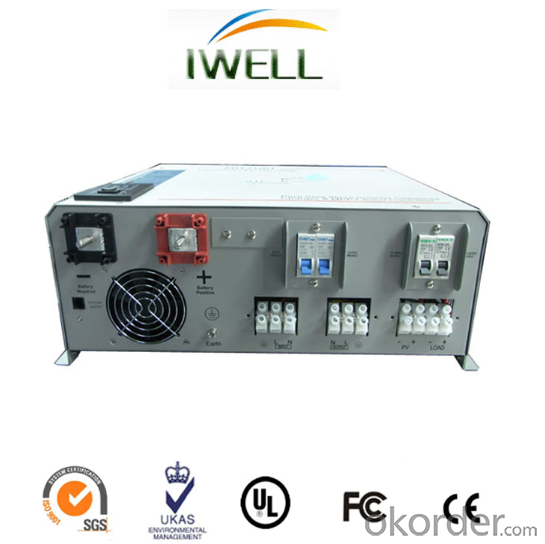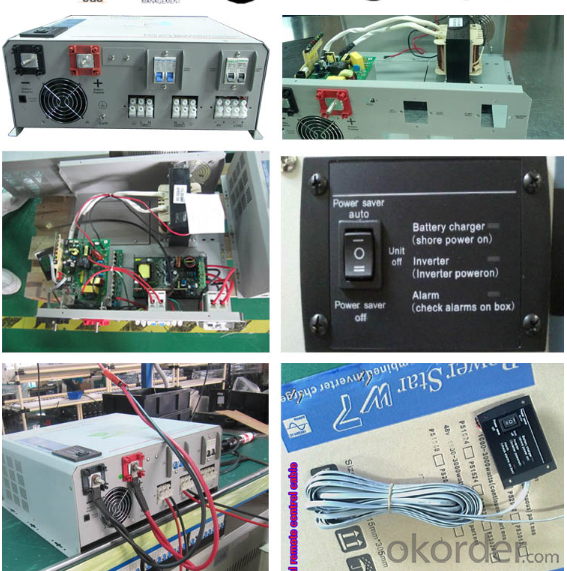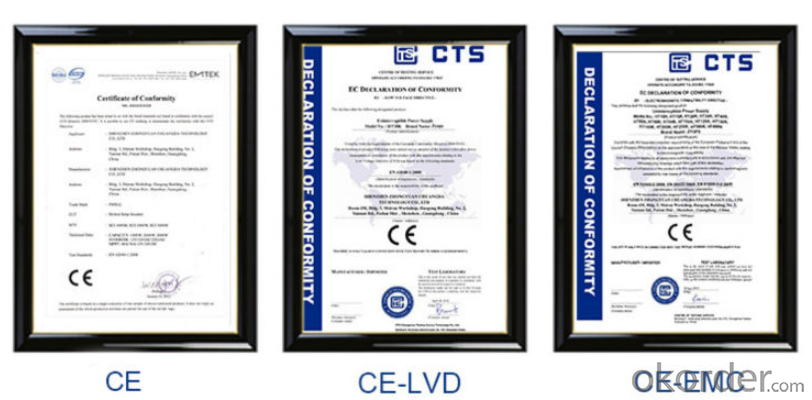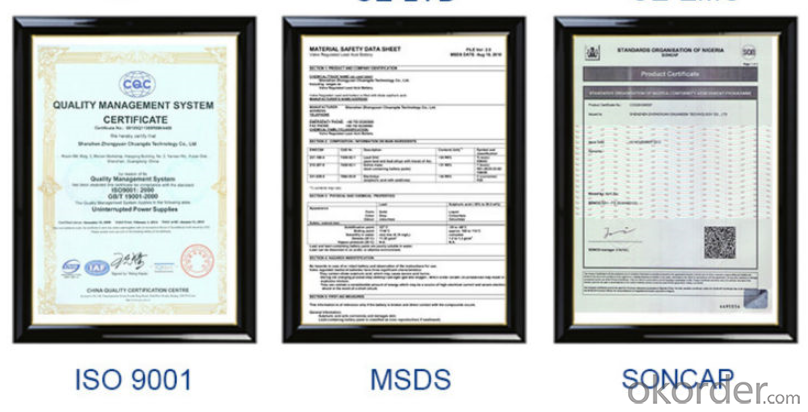Solar System 12V 24V 1-3KW Inverter with Controller and Charger Pure Sine Wave
- Loading Port:
- Qingdao
- Payment Terms:
- TT or LC
- Min Order Qty:
- 50 unit
- Supply Capability:
- 3000 unit/month
OKorder Service Pledge
OKorder Financial Service
You Might Also Like
1. Structure of Solar System 12V 24V 1-3KW Inverter with Controller and Charger Pure Sine Wave
A solar inverter, or PV inverter, or Solar converter, converts the variable direct current (DC) output of a photovoltaic (PV) solar panel into a utility frequency alternating current (AC) that can be fed into a commercial electrical grid or used by a local, off-grid electrical network.
It is a critical BOS–component in a photovoltaic system, allowing the use of ordinary AC-powered equipment.
Solar inverters have special functions adapted for use with photovoltaic arrays, including maximum power point tracking and anti-islanding protection.
2. Main Features of the Solar System 12V 24V 1-3KW Inverter with Controller and Charger Pure Sine Wave
﹒Output waveform: pure sine wave
﹒High efficiency>85%
﹒12v or24v or 48vDC input
﹒AC100V or AC110V or AC120V/220v /230V /240V AC output
﹒Output frequency 60HZ or 50HZ
﹒Continuous output power:10KW
﹒High-velocity cooling fan
﹒Overload protect ,over voltage protect ,low voltage cut-out ,low voltage alarm
3. Solar System 12V 24V 1-3KW Inverter with Controller and Charger Pure Sine Wave Images





4. Solar System 12V 24V 1-3KW Inverter with Controller and Charger Pure Sine Wave Specification
Mode | PTV 500W | PTV 1000W | PTV 1500W | PTV 2000 | PTV 3000 |
Continuous power (W) | 500W | 1000W | 1500W | 2000W | 3000W |
Surge capability (W) | 1500W | 3000W | 4500W | 6000W | 6000W |
System DC input (VDC) | 12VDC | 24VDCV | 24VDC | 24VDC | 24VDC |
AC Output | 110 / 120V/ 220V/230V ±5% , 50HZ or 60HZ. Terminal | ||||
AC Output waveform | Pure Sine Wave | ||||
DC output | 12VDC or 24VDC Terminal | ||||
Efficiency | 88% | ||||
AC/DC Charger | Max 15A | Max 25A | Max 25A | Max 40AMP | Max 50 |
Solar Charge Controller | MPPT,20AMP | MPPT,30AMP | MPPT,40AMP | MPPT,50AMP | MPPT 100AMP |
Adviced PV | 36 or 72 Cell | 72 Cell | 72 Cell | 72 Cell | 72 Cell |
External battery back | 12 or 24VDC | 24VDC | 24VDC | 24VDC | 24VDC |
Breakers | with Breakers for AC Input , AC output, PV input , DC output | ||||
Battery low protection | yes | ||||
Over discharge protection | yes | ||||
Resume voltage | yes. When fault remove | ||||
Over voltage protection | yes | ||||
Overload protection | yes. | ||||
With cooling fan | yes | ||||
Display | LED for Inverter,charger,Battery Capacity state, DC load state and fault. LCD display is optional | ||||
Running Temperature | -35 degree to 55 degree | ||||
High temperature protection | YES | ||||
Short circuit protection | YES | ||||
Reverse polarity protection | YES. Only for DC load side. | ||||
Stand by | yes. continou ouput while > 25W | ||||
Communication | RS232 Power Manager, NetAgent SNMP , Optional for LED mode | ||||
Package Size(mm) | 608*558*293 | 608*558*293 | 608*558*293 | 608*558*293 | 608*558*293 |
Gross Weight KG | 21 | 24 | 24 | 26 | 32 |
product Size (mm) | 460*440*200 | 460*440*200 | 460*440*200 | 460*440*200 | 460*440*200 |
product weight( kg) | 15KG | 16KG | 16KG | 19.5KG | 24KG |
5. FAQ of Solar System 12V 24V 1-3KW Inverter with Controller and Charger Pure Sine Wave
Q1. What is the difference between inverter and solar inverter?
A1. Inverter only has AC inpput, but solar inverter both connect to AC input and solar panel, it saves more power.
Q2. What is the difference between MPPT&PWM?
A2. MPPT has higher efficiency, it can track the max power point and won't waste energy.
Q3. What is the waranty of product?
A3. 12 months.
- Q:Can a solar inverter be used with different types of tracking algorithms?
- Yes, a solar inverter can be used with different types of tracking algorithms. The inverter is designed to convert the DC power generated by solar panels into usable AC power for various applications. The tracking algorithm, on the other hand, is responsible for optimizing the solar panel's orientation to maximize energy production. Different tracking algorithms like fixed tilt, single-axis, or dual-axis can be employed with the solar inverter to enhance energy harvesting based on factors such as sun's position, time of day, and weather conditions.
- Q:How does a solar inverter handle varying solar irradiance levels?
- A solar inverter handles varying solar irradiance levels by continuously monitoring the incoming solar power and adjusting its output accordingly. It employs a maximum power point tracking (MPPT) algorithm that optimizes the energy conversion from the solar panels to the desired AC power output. When solar irradiance levels fluctuate, the inverter dynamically adapts to ensure the maximum power is extracted from the solar panels. This allows for efficient energy conversion and maximum utilization of the available solar power.
- Q:Can a solar inverter be used in areas with high seismic activity?
- Certainly, a solar inverter can be utilized in regions with high seismic activity. Nevertheless, it is imperative to guarantee that the solar inverter is engineered to endure and operate securely under such circumstances. Solar inverters are commonly constructed with sturdy and long-lasting materials to withstand a range of environmental factors, including seismic activity. They frequently undergo testing and certification to meet specific standards for seismic resistance. When installing a solar inverter in an area with high seismic activity, it is vital to adhere to the manufacturer's guidelines and recommendations. This may involve implementing additional measures such as reinforced mounting structures, flexible connections, and appropriate grounding techniques to enhance the stability and resilience of the inverter system. Furthermore, routine maintenance and inspections should be carried out to ensure that the solar inverter remains in optimal working condition even after seismic events. This entails examining for any indications of damage, loose connections, or other potential issues that may have arisen due to seismic activity. By taking necessary precautions and employing seismic-resistant solar inverters, it is plausible to safely and efficiently harness solar energy even in areas prone to seismic activity.
- Q:What is a solar inverter?
- A solar inverter is an electronic device that converts the direct current (DC) electricity generated by solar panels into alternating current (AC) electricity, which is suitable for use in homes, businesses, and the electrical grid.
- Q:PV grid-connected inverter and independent inverter in the control of what is the difference
- PV grid-connected inverter in the grid before the inverter needs to determine the phase voltage phase frequency, the first phase-locked, in the grid and power generation.
- Q:What is the role of a solar inverter in reactive power compensation during grid disturbances?
- The role of a solar inverter in reactive power compensation during grid disturbances is to regulate and stabilize the flow of reactive power from the solar panels to the grid. During grid disturbances, such as voltage fluctuations or power imbalances, the inverter adjusts the reactive power output to maintain grid stability and improve power quality. By injecting or absorbing reactive power as needed, the solar inverter helps to maintain the grid voltage within acceptable limits and minimize disruptions in the power supply.
- Q:Can a solar inverter be used with different types of electrical appliances?
- Yes, a solar inverter can be used with different types of electrical appliances. Solar inverters are designed to convert the direct current (DC) generated by solar panels into alternating current (AC) that is compatible with standard household appliances. As long as the electrical appliances operate on AC power within the inverter's specified power range, they can be used with a solar inverter.
- Q:What is the role of a solar inverter in a solar-powered ventilation system?
- The role of a solar inverter in a solar-powered ventilation system is to convert the direct current (DC) generated by solar panels into alternating current (AC) that can be used to power the ventilation system. It ensures that the electricity generated by the solar panels is compatible with the system's requirements and can efficiently operate the ventilation components.
- Q:How does a solar inverter handle grid disturbances (voltage sags, swells, flickers)?
- A solar inverter handles grid disturbances such as voltage sags, swells, and flickers by constantly monitoring the grid's voltage and frequency. When a disturbance occurs, the inverter utilizes its internal control mechanisms to adjust the solar power output accordingly. It can compensate for voltage sags by injecting additional power into the grid, and it can reduce power output during voltage swells to prevent overloading. Additionally, the inverter's control algorithms help minimize flickering by maintaining a stable and consistent power supply to the grid.
- Q:Are there any specific installation requirements for solar inverters?
- Solar inverters have specific installation requirements that should be taken into consideration. Here are some important factors to keep in mind: 1. Placement: To ensure optimal performance and durability, solar inverters should be installed in a well-ventilated area, away from direct sunlight and potential heat sources. Additionally, they should be placed in a clean and dry environment. 2. Mounting: Solar inverters can be mounted on walls or placed on flat surfaces. However, it is crucial to follow the manufacturer's guidelines for proper mounting techniques and ensure that they are securely fastened. 3. Wiring: Adequate wiring is essential for connecting the solar panels to the inverter and the inverter to the electrical grid. The wiring should be appropriately sized based on the system's specifications to handle voltage and current requirements without any voltage drop or overheating. 4. Electrical connections: The inverter should be connected to a dedicated circuit breaker or fuse in the main electrical panel. This circuit breaker or fuse must be properly sized to protect the inverter and the electrical system from potential hazards. 5. Clearances: Specific clearances are required to ensure proper ventilation and prevent overheating of solar inverters. The manufacturer's guidelines should be followed to determine the necessary clearances around the inverter. 6. Monitoring and safety devices: Certain inverters may require additional monitoring and safety devices, such as surge protectors, arc fault circuit interrupters (AFCIs), or rapid shutdown devices. These devices should be installed according to the manufacturer's instructions and local electrical codes. 7. Compliance with regulations: Compliance with local electrical codes and regulations is crucial during the installation of solar inverters. This may include obtaining necessary permits and inspections to ensure a safe and compliant installation. To ensure that all specific requirements are met for your particular system, it is highly recommended to seek guidance from a professional solar installer or electrician who has expertise in solar inverter installations.
1. Manufacturer Overview |
|
|---|---|
| Location | |
| Year Established | |
| Annual Output Value | |
| Main Markets | |
| Company Certifications | |
2. Manufacturer Certificates |
|
|---|---|
| a) Certification Name | |
| Range | |
| Reference | |
| Validity Period | |
3. Manufacturer Capability |
|
|---|---|
| a)Trade Capacity | |
| Nearest Port | |
| Export Percentage | |
| No.of Employees in Trade Department | |
| Language Spoken: | |
| b)Factory Information | |
| Factory Size: | |
| No. of Production Lines | |
| Contract Manufacturing | |
| Product Price Range | |
Send your message to us
Solar System 12V 24V 1-3KW Inverter with Controller and Charger Pure Sine Wave
- Loading Port:
- Qingdao
- Payment Terms:
- TT or LC
- Min Order Qty:
- 50 unit
- Supply Capability:
- 3000 unit/month
OKorder Service Pledge
OKorder Financial Service
Similar products
New products
Hot products
Related keywords





























